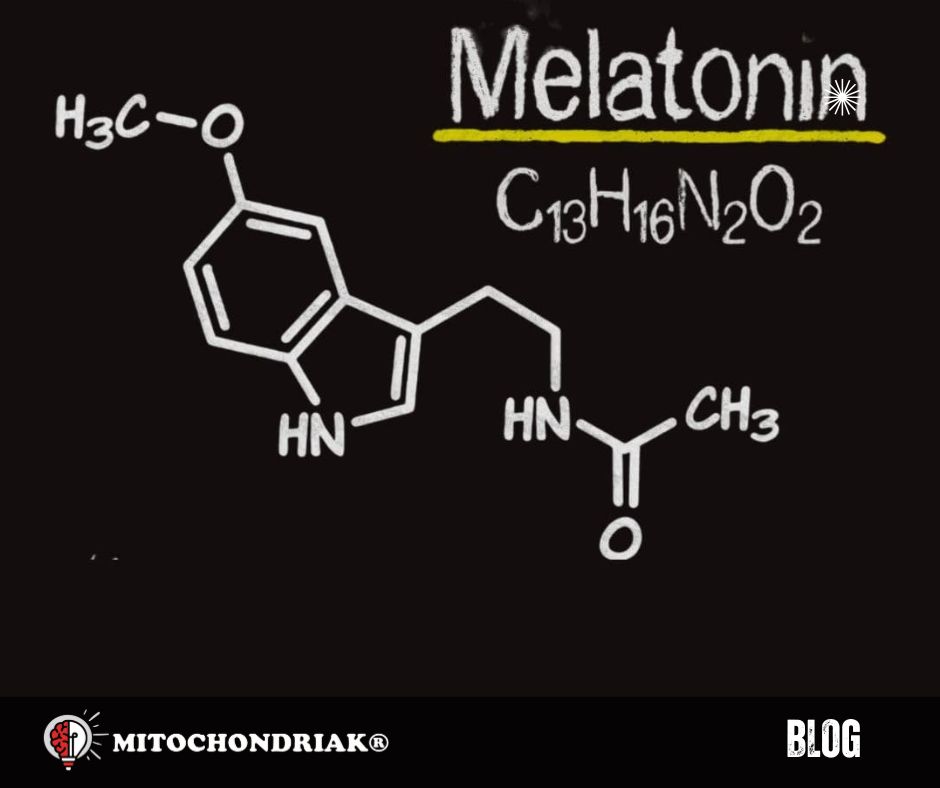The hormone melatonin is probably one of the most important hormones in our body, which regulates not only our sleep, but also our own mitochondria, their autophagy and apoptosis and therefore our hydration and energy in body. In today's blog post we will take a closer look at it. You will learn how mitochondria produce melatonin, and you will also find practical tips on how to increase it by natural ways.
Content:
- What is the hormone melatonin and where in the body is it produced?
- What are the roles of melatonin in the body?
- How light stimulates melatonin production?
- Why not take melatonin in a supplement, but rather focus on increasing its natural production in the body?
- Practical tips for increasing melatonin production
- Is red light therapy a great mitohack "tool" to improve melatonin?.
What is melatonin and where in the body is it produced?
Melatonin is most commonly known as the sleep hormone. And while the primary synthesis of melatonin occurs in our pineal gland (in the brain), especially when we sleep and are in the dark, modern research and studies show that our mitochondria are also capable of producing melatonin. Research has shown that in our early evolution, melatonin began as a powerful antioxidant and only later developed its role in sleep.. [9, 10]
It is also interesting that the concentration levels of melatonin produced by mitochondria are not affected by circulating levels of melatonin in the blood, suggesting a multipurpose function of melatonin. One could say that the hormone melatonin influences almost everything that happens in our body, including its very functioning.
What are the functions of melatonin?
Melatonin, which is produced by our mitochondria, helps them in their own regeneration, thanks to which:
- Improves sleep.
- Maintains circadian rhythm.
- Helps with the so-called cell death (apoptosis), thanks to which the body degrades heavily damaged cells, e.g. cancer cells.
- Helps with the recycling of its own cells, including mitochondria (autophagy), thanks to which mitochondria heal on a daily basis.
- Increases energy production in the body.
- Increases hydration (because it improves water production in mitochondria).
- Regulates high cortisol and stress.
- And much more.
How light (especially red and infrared) stimulates melatonin production
Researchers have demonstrated melatonin biosynthesis in mitochondria of different species and different cell types [8-10]. Odinokov and Hamblin [11] proposed that NIR photons stimulate subcellular or extrapineal melatonin biosynthesis through activation of cyclic adenosine monophosphate (AMP) or NF-κB or alternatively by stimulating bone marrow stem cells.
In layman's terms, this means that it is red and near-infrared (NIR) light, which we have an abundance of during the day when the sun is shining, that can stimulate the production of melatonin in our own cells in the body. In mitochondria.
One study found that athletes who were exposed to red light for 30 minutes every night for 14 days had better quality sleep and secreted more melatonin during sleep.

Why not take melatonin in a supplement, but rather focus on increasing its natural production in the body
As you can see in the video above, melatonin is a hormone that our bodies and mitochondria produce by their own, and is based on the light we are exposed to during the day. If we take a supplement to artificially increase it, our bodies and mitochondria can respond by changing their own production. But if they are already producing less of it, what will happen if they receive a signal from outside that they can produce even less?
Some studies also suggest that oral melatonin contributes to retinal degeneration, especially when used by young people and children, making their eyes less able to handle oxidative stress. [16, 17] That's why we should always focus primarily on its natural support.
Practical tips for increasing melatonin
1. Be active during the day.
Regular exercise and movement increase body temperature, energy expenditure, and even the work of mitochondria, which makes them produce more melatonin..
2. Expose yourself to sunlight in the morning and throughout the day.
Always try to go outside for at least a few minutes during the day, every day, consistently, and get some natural sunlight. This way you will get plenty of free red and infrared light, which stimulates melatonin production and better sleep.
3. Don't eat shortly before bedtime.
Digestion and metabolism are governed by circadian rhythms, so try to eat your last meal a few hours before bedtime to help melatonin secretion.
4. Keep the bedroom at a cooler temperature
During sleep, the human body temperature naturally decreases. Thanks to the drop in temperature, our pineal gland secretes melatonin more easily at night.
5. Limit blue light in the evening.
Although blue light is a great advance, making our phones and computers more powerful, it also brings with it many negatives, because it "deceives" our brain and circadian rhythm that it is daytime, which can impair our sleep quality and falling asleep.
If you have some inappropriate lighting at home in the evening, or you watch TV or another screen, we recommend trying the practical blue light blogking glasses and also dimmed red lights, which, on the contrary, supports sleep and melatonin secretion.
Indoor lightning solutionsBlue light blocking glasses
Is red light therapy a great mitohack "tool" to improve melatonin?
Red and infrared light therapy, also known as low-level light therapy (LLLT), or photobiomodulation, is a non-invasive therapy that involves exposing the body to low levels of specific red (RED) or near-infrared (NIR) light.
The wavelengths of red and infrared light have unique properties, including the ability to penetrate several milimitres or centimeters into the skin and stimulate various cellular processes in the body, including melatonin production.
With Mitochondriak® red light devices, you can achieve such therapy very easily. For example, with our well designed Mitochondriak® products you will support melatonin production in body. You can use bigger devices or smaller models, and you can design the therapy according to your needs.
.jpg)
Indoor lightning
Flicker and blue light free sunset bulbs + blue light blocking glasses
References and studies:
- https://pubmed.ncbi.nlm.nih.gov/23182016/
- https://www.ncbi.nlm.nih.gov/pmc/articles/PMC3499892/
- https://pubmed.ncbi.nlm.nih.gov/17321060/
- https://www.ncbi.nlm.nih.gov/pmc/articles/PMC6725211/
- https://www.ncbi.nlm.nih.gov/pmc/articles/PMC10001099/
- https://pubmed.ncbi.nlm.nih.gov/27276063/
- https://www.melatonin-research.net/index.php/MR/article/view/19/208
- Suofu Y, et al. (2017) Dual role of mitochondria in producing melatonin and driving GPCR signaling to block cytochrome c release. PNAS 114 (38): E7997-E8006.
- He C, Wang J, Zhang Z, Yang M, Li Y, Tian X, Ma T, Tao J, Zhu K, Song Y, Ji P, Liu G (2016). Mitochondria Synthesize Melatonin to Ameliorate Its Function and Improve Mice Oocyte's Quality under in Vitro Conditions. Int. J. Mol. Sci. 17 (6): E939. doi: 10.3390/ijms17060939.
- Wang L, Feng C, Zheng X, Guo Y, Zhou F, Shan D, Liu X, Kong J. (2017) Plant mitochondria synthesize melatonin and enhance the tolerance of plants to drought stress. J. Pineal Res. 63 (3): E12429. doi: 10.1111/jpi.
- Odinokov D, Hamblin MR (2018) Aging of lymphoid organs: Can photobiomodulation reverse age-associated thymic involution via stimulation of extrapineal melatonin synthesis and bone marrow stem cells? J. Biophot. 11 (8): e201700282.
- https://www.ncbi.nlm.nih.gov/pmc/articles/PMC2796659/
- https://pubmed.ncbi.nlm.nih.gov/18081143/
- Konturek PC, Brzozowski T, Konturek SJ. Gut clock: implication of circadian rhythms in the gastrointestinal tract. J Physiol Pharmacol. 2011 Apr.
- St-Onge AP, Mikic A, and Pietrolungo C. Effects of Diet on Sleep Quality. Advances in Nutrition. 2016 Sept.
- https://iovs.arvojournals.org/article.aspx?articleid=2160933
- https://pmc.ncbi.nlm.nih.gov/articles/PMC2785757/
.png)

